1. Adler N, Matthews K. Why do some people get sick and some stay well? Annu Rev Psychol. 1994; 45:229–259. PMID:
8135503.
2. Cho JW. Analysis of regional dietary intake of adolescents in Korea. 2002. Seoul National University of Korea;Master's Thesis.
3. Cho KY. The study on the dietary behavior and the state of health of boys' and girls' middle school students. 1993. Hanyang University of Korea;Master's Thesis.
4. Cho WJ, Kwon IS, Lee HJ. A study on dietary practice and stress. Journal of the Korean Society of School Health. 1998; 11:285–295.
5. Choi JH. An ecological study on eating behaviors of middle school students in Seoul. 1995. Yonsei University of Korea;Master's Thesis.
6. Gray GE. Crime and Diet: is there a relationship? World Rev Nutr Diet. 1987; 49:66–86. PMID:
3554783.

7. Han MJ, Cho HA. The Food habit and stress scores of high school students in Seoul area. Korean Journal of Food and Cookery Science. 2000; 16:84–90.
8. Ha JS, Lee HG. Effect of middle-school students' food behaviors on health conditions and degrees of study accomplishments. Journal of Korean Home Economics Association. 1995; 33:225–242.
9. Holmes TH, Rahe RH. The social readjustment rating scale. Journal of Psychosmatic Research. 1967; 11:213–218.

10. Hong YJ. A Study on the relation of eating behaviors and food intakes to the obesity index of adolescents. Korean Journal of Dietetic Culture. 1999; 143:535–554.
11. Jang YA, Kim HY, Oh SY, Han SS, Lee HS, Won HS, Kim SH, Kim WK, Cho SS. A study for dietary attitudes and food behaviors of elementary, middle and high school students of Korea. Journal of Korean Home Economics Association. 2000; 38:85–97.
12. Joo EJ, Park ES. Effect of gender and obese index on breakfast and snack intakes in elementary school students. Korean Journal of Dietetic Culture. 1998; 13:487–496.
13. Joo NM, Kim SH, Park HN, Lee SY, Kim MJ, Jung KS. The effect of snack intake of preschoolers on ADHD. Korean Journal of Dietetic Culture. 2006; 21:193–201.
14. Kang SA, Lee JW, Kim KE, Koo JO, Park DY. A study of the frequency of food purchase for snacking and its related ecological factors on elementary school children. Korean Journal of Community Nutrition. 2004; 9:453–463.
15. Kim DM. Eating attitude, self-esteem and perceived stress among middle school girls. 2003. Korea University of Korea;Master's Thesis.
16. Kim EJ. Stress degree and dietary practices of high school students in Ulsan area. 2001. Korea University of Korea;Master's Thesis.
17. Kim EY, Park HH. A study on eating habits of elementary school students in higher grades. Korean Journal. of Food and Nutrition. 2004; 17:393–404.
18. Kim MK, Shin DS, Wang SK. Effect of the nutrient intakes on psycho-social stress. Korean Journal of Dietetic Culture. 1995; 10:405–417.
19. Kim MR, Hong KJ, Yang SN. High school student's stress and their coping styles. The Korean Journal of Youth. 2002; 10:107–125.
20. Kim SY. A study on the factors of stress and the stress coping styles of middle school students. 2000. Chonbuk National University of Korea;Master's Thesis.
21. Koo JO, Lee JW, Choi YS, Kim JH, Lee JH. Nutrition throughout the life cycle. 2006. Seoul. Republic of Korea: Hyoil Publishing Co..
22. Kwon SY. A study of dietary patterns and analysis of the factors that influence snack intake of the middle school students in Seoul. 2005. Sookmyung Woman's University of Korea;Master's Thesis.
23. Lee KS, Park SY. A study on the perceived stress and social supports of adolescents. Korean Home Economics Association. 2000; 38:93–106.
24. Lee SW, Son KH, Lee YM. A study on the eating attitudes of male and female middle school students. 1985. Yonsei University of Korea;Master's Thesis.
25. Lee YM, Han MS. Nutritional knowledge and eating behaviors of high school students in Sungnam area. Korean Journal of Dietetic Culture. 1996; 11:305–316.
26. McCann BS, Warnick GR, Knopp RH. Changes in plasma lipids and dietary intake accompanying shifts in perceived workload and stress. Psychosom Med. 1999; 52:97–108. PMID:
2305026.

27. Michard CI, Kahn JP, Musse N, Burlet C, Nicolas JP, Mejean J. Relationships between a critical life event and eating behaviors in high school students. Stress Med. 1990; 6:57–64.
28. Moon SJ, Lee MH. An effect of children's food attitudes on nutritional status and personality. Korean Journal of Nutrition. 1987; 20:258–271.
29. Nam HJ, Lee SM, Park HR. An ecological study on dietary behaviors by the degrees of stress among female college students in Suwon. Korean Journal of Health education and promotion. 2002; 19:199–212.
30. National Rural Living Science Institute, Rural Development Administration. Food Composition Tables for Consumers. 2002. Seoul. Republic of Korea:
31. Oliver G, Wardle J. Perceived effects of stress on food choices. Physiol Behav. 1999; 66:511–515. PMID:
10357442.
32. Park MS, Hong KJ, Cho YS, Lee JW. A study on the promotion of adolescent milk consumption (2)-Relationships of adolescent milk intake frequency with food attitude, snacking frequency, physical activity and school vending facilities. Journal of the Korean Dietetic Association. 2007; 13:73–83.
33. Park SJ. Survey on the fatness extents of middle school in Seoul on their habits and their tendencies. 2002. Sejong University of Korea;Master's Thesis.
34. Park YS. Intake of snacks by the Elementary School Children in Hansan-do area. Korean Journal of Food and Cookery Science. 2003; 19:96–106.
35. Park HY, Kim KN. Relationships among snacks, unbalanced diets, and eating behaivors of middle school students. Journal of Korean Home Economics Education Association. 1995; 7:79–89.
36. Parraga IM. Determinants of consumption. J Am Diet Assoc. 1990; 90:661–663. PMID:
2335679.
37. Sin EK, Lee YK. Menu development and evaluation through eating behaviors and food preferences of preschool children in Day-Care Centers. Korean Journal of Dietetic Culture. 2005; 20:1–14.
38. The Korean Dietetic Association. Guide to portion size estimation with food pictures. 1999. Seoul. Republic of Korea:
39. The Korean Nutrition Society. Recommended dietary allowances for Koreans, 7th Revision. 2000. Seoul. Republic of Korea:
40. The Korean Nutrition Society. Dietary Reference Intakes for Koreans. 2005. Seoul. Republic of Korea: Kookjin Publishing Co.
41. Wardle J, Steptoe A, Oliver G, Lipsey Z. Stress, dietary restraint and food intake. J Psychoson Res. 2000; 48:195–202.

24. Yeom HJ. A relation of the stress status on the food ecology and health behaviors in elementary school children. 2001. Ewha Woman's University of Korea;Master's Thesis.
43. Yoo AJ, Han MH. Development of Daily Hassles Scale for Children in Korea. Journal of Korean Home Economics Association. 1995; 33:49–64.
44. Yoo SY, Song YJ, Joung HJ, Paik HY. Dietary assessment using dietary pattern analysis of middle school students in Seoul. Korean Journal of Nutrition. 2004; 37:373–384.

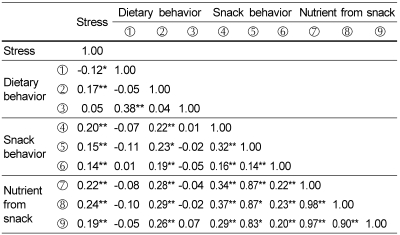




 PDF
PDF ePub
ePub Citation
Citation Print
Print


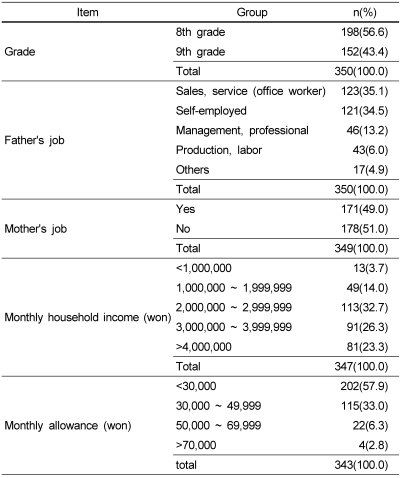
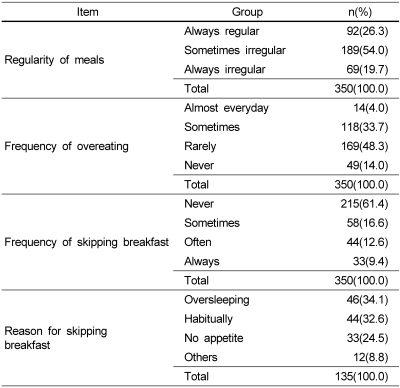
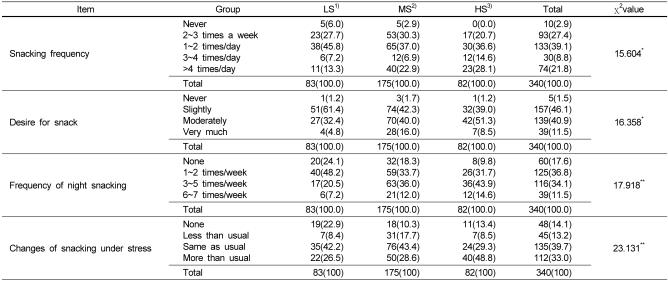
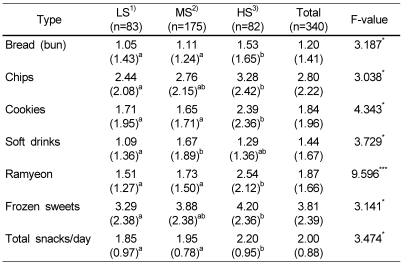
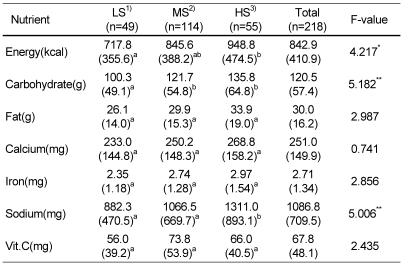
 XML Download
XML Download